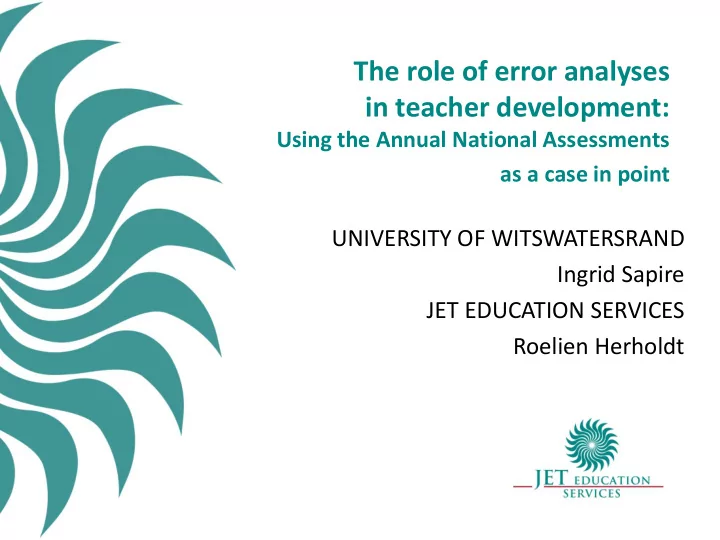

The role of error analyses in teacher development: Using the Annual National Assessments as a case in point UNIVERSITY OF WITSWATERSRAND Ingrid Sapire JET EDUCATION SERVICES Roelien Herholdt
Background Annual National Assessments (ANA) • Compulsory part of education in SA Action Plan towards 2014 states the aims of the ANA • Examples of assessment standards and methods • Better targeted district support • Evaluation of school performance • Provide School Governing Bodies and parents with information This implies two broad purposes: • Guiding interventions at district, school and learner level • Provision of system level measure of learner achievement in key subjects 2
Background cont. Diagnostic reports • Guidelines on how to interpret the ANA results on different levels of system • Guidelines are quite specific regarding the process to follow in analysing learner result • Broad discussions of areas of weakness • Broad suggestions for teaching Effective use of assessment data require high levels of expertise from teachers • Administer and mark the assessment • Link the assessment items to specific skills/knowledge/concepts • Interpret learner responses • Provide relevant and constructive feedback • Adjust own teaching 3
Annual National Assessment (ANA) Provide regular, well-timed, valid and credible data on learner achievement. Meant to be used for both diagnostic purposes at individual learner level and at systemic level. Teachers: 1. Always needed to recognise learners’ errors. 2. Now required “ to interpret their own learners’ performance in national (and other) assessments” (Government plan for teacher education and development, 2011-2025). 4
The pilot project The value that ANA offers for improving learning lies in the capacity of the Provincial Departments to support districts, schools and teachers to take up the ANA information and use it for improvement (Bansilal, 2012). The analysis and use of assessment information by teachers, principals, circuit managers and curriculum advisers to improve learning outcomes is still in its infancy (Mandinach et al, 2006:4; Brunner et al, 2005). What did we want to find out? How did we go about it? 5
What we learned so far? • General identification of skill addressed in question • Struggled to place specific skill in hierarchy of skills • Focussed on overall results and trends • Focussed on right or wrong • Struggled to interpret the learners level of understanding • Struggled to interpret partial understanding and alternative methods • Struggled to formulate teaching strategies to address weak areas 6
What is Error analyses • Error analysis is a multifaceted activity – it involves analysis of correct, partially correct and incorrect methods of solution. It is useful since errors are pervasive. Research in mathematics education has shown that: • a focus on errors, as evidence of reasonable and interesting mathematical thinking on the part of learners • helps teachers to understand learner thinking, to adjust the ways they engage with learners in the classroom situation • and revise their teaching approach. 7
Why do error analyses ? • DIPIP project • Tests provided an artefact used in a structured learning opportunity to facilitate teacher development. • Error analysis: • Helps teachers to understand learner thinking • About concepts • About misconceptions • Helps teachers to adjust their teaching strategies • Helps teachers to think about how they engage with learners 8
Error analysis activity template • Study the item. • Study the data related to the item. • Think about the knowledge required to answer the item. • Think about what learners might have been thinking when they got the wrong answers. • What does this activity teach you about the way you would teach the content in the item? • Plan an activity to address at least one of the errors you identified relating to the item. 9
Extract from Grade 3 learner L script 374 – 127 = Correct 14.7 Added 2.9 Subtracted but used vertical 17.6 algorithm incorrectly Rewrote the first number 1.4 Other incorrect answer 61.8 Didn't attempt question 1.6 100 10
Conclusion • Put teachers at the centre of test analysis in their own classrooms – encourage and enable this activity. • Use error analysis in mediated learning forums • Error analysis enables the development of pedagogical content knowledge of teachers • Move away from a compliance based approach towards a developmental approach Thank you 11
Recommend
More recommend